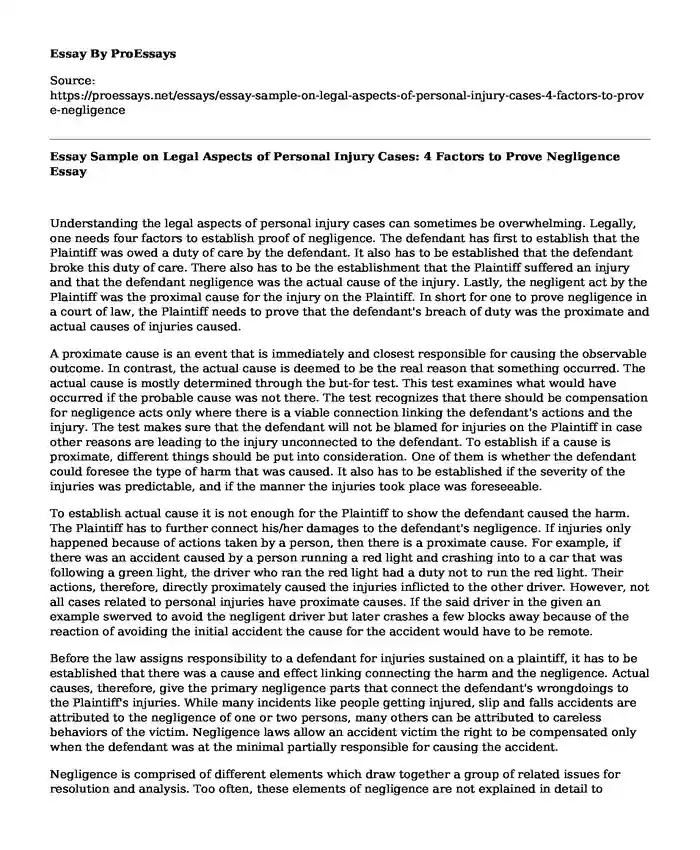Understanding the legal aspects of personal injury cases can sometimes be overwhelming. Legally, one needs four factors to establish proof of negligence. The defendant has first to establish that the Plaintiff was owed a duty of care by the defendant. It also has to be established that the defendant broke this duty of care. There also has to be the establishment that the Plaintiff suffered an injury and that the defendant negligence was the actual cause of the injury. Lastly, the negligent act by the Plaintiff was the proximal cause for the injury on the Plaintiff. In short for one to prove negligence in a court of law, the Plaintiff needs to prove that the defendant's breach of duty was the proximate and actual causes of injuries caused.
A proximate cause is an event that is immediately and closest responsible for causing the observable outcome. In contrast, the actual cause is deemed to be the real reason that something occurred. The actual cause is mostly determined through the but-for test. This test examines what would have occurred if the probable cause was not there. The test recognizes that there should be compensation for negligence acts only where there is a viable connection linking the defendant's actions and the injury. The test makes sure that the defendant will not be blamed for injuries on the Plaintiff in case other reasons are leading to the injury unconnected to the defendant. To establish if a cause is proximate, different things should be put into consideration. One of them is whether the defendant could foresee the type of harm that was caused. It also has to be established if the severity of the injuries was predictable, and if the manner the injuries took place was foreseeable.
To establish actual cause it is not enough for the Plaintiff to show the defendant caused the harm. The Plaintiff has to further connect his/her damages to the defendant's negligence. If injuries only happened because of actions taken by a person, then there is a proximate cause. For example, if there was an accident caused by a person running a red light and crashing into to a car that was following a green light, the driver who ran the red light had a duty not to run the red light. Their actions, therefore, directly proximately caused the injuries inflicted to the other driver. However, not all cases related to personal injuries have proximate causes. If the said driver in the given an example swerved to avoid the negligent driver but later crashes a few blocks away because of the reaction of avoiding the initial accident the cause for the accident would have to be remote.
Before the law assigns responsibility to a defendant for injuries sustained on a plaintiff, it has to be established that there was a cause and effect linking connecting the harm and the negligence. Actual causes, therefore, give the primary negligence parts that connect the defendant's wrongdoings to the Plaintiff's injuries. While many incidents like people getting injured, slip and falls accidents are attributed to the negligence of one or two persons, many others can be attributed to careless behaviors of the victim. Negligence laws allow an accident victim the right to be compensated only when the defendant was at the minimal partially responsible for causing the accident.
Negligence is comprised of different elements which draw together a group of related issues for resolution and analysis. Too often, these elements of negligence are not explained in detail to provide a clear distinction between them as this paper has tried to establish.
Cite this page
Essay Sample on Legal Aspects of Personal Injury Cases: 4 Factors to Prove Negligence. (2023, Oct 25). Retrieved from https://proessays.net/essays/essay-sample-on-legal-aspects-of-personal-injury-cases-4-factors-to-prove-negligence
If you are the original author of this essay and no longer wish to have it published on the ProEssays website, please click below to request its removal:
- Organizing Framework and Program Outcomes
- Infant Mortality in Afghanistan Essay
- Preventing Juvenile Delinquency Essay
- Essay Example on Death Penalty: Arguing Against Bedau's Ideas
- The Value of Critical Thinking as a Registered Nurse: Annotated Bibliography
- Essay on Forensic Serology: Observing, Grouping & Classifying Body Fluids in Crime Scenes
- Essay Example on Potassium Intake for Adults: DRI vs US Average







